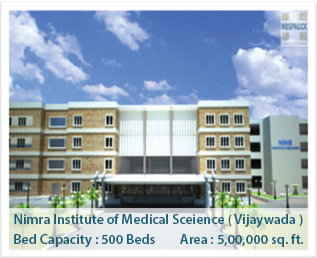Are you currently looking into venturing or investing into the healthcare sector of India? Are you looking for concrete details on the current status of the Healthcare scenario in India? In this article, Hospacxx Healthcare Consultancy brings to you the latest bits of Information on India’s current Healthcare Systems and their upcoming new sectors.
INTRODUCTION
India is a country with a population of 1.3 billion people, making it one of the largest and most diverse healthcare systems in the world. The healthcare system in India faces several challenges, including inadequate infrastructure, unequal distribution of resources and a growing burden of non-communicable diseases. Despite these challenges, India is known for producing highly skilled healthcare professionals and offering low-cost treatments, making it a popular destination for medical tourism. In this blog, we will explore the current prevalence of diseases, infrastructure, market size, growth factors, challenges and government initiatives in India.

HEALTHCARE INDUSTRY MARKET SCENARIO OF INDIA

HEALTHCARE SECTOR COMPOSITION
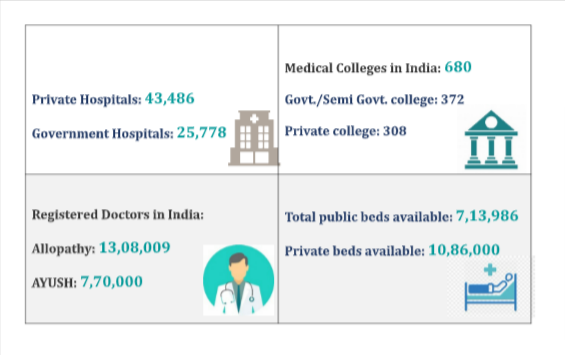
MEDICAL TOURISM IN INDIA
As per Federation of India Chambers of Commerce & Industry(FICCI), India received around 6,50,000 medical tourists in the Year 2022. The Indian medical tourism industry estimated to be valued at US$ 7,4117 million in 2022 and it is projected to surpass US$ 42,237 million by 2032. Due to the low-cost treatments available in India, it ranks at number 7 amongst the 20 wellness tourism markets. It also ranks at number 3 in wellness-focused countries in the Asia Pacific. The low cost of medical treatments is the primary factor in attracting tourists from around the globe.
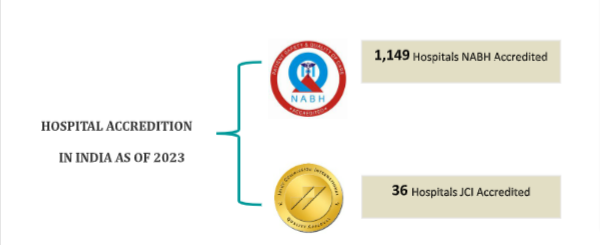

According to the 2022 statistics reported by the World Health Organization (WHO), India faces challenges in its healthcare system, with an average of 0.53 hospital beds per 1,000 population. The doctor-to-population ratio is 1:834 when considering all registered allopathic and AYUSH doctors, indicating a shortage of doctors in the country. The nurses-to-population ratio is 1.96 nurses per 1,000 population.
INDIA’S KEY HEALTH INDICATORS
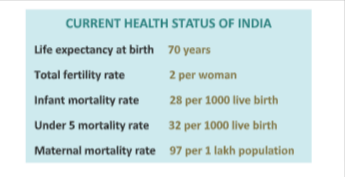
CONTRIBUTION OF DISEASE CONDITION IN INDIA
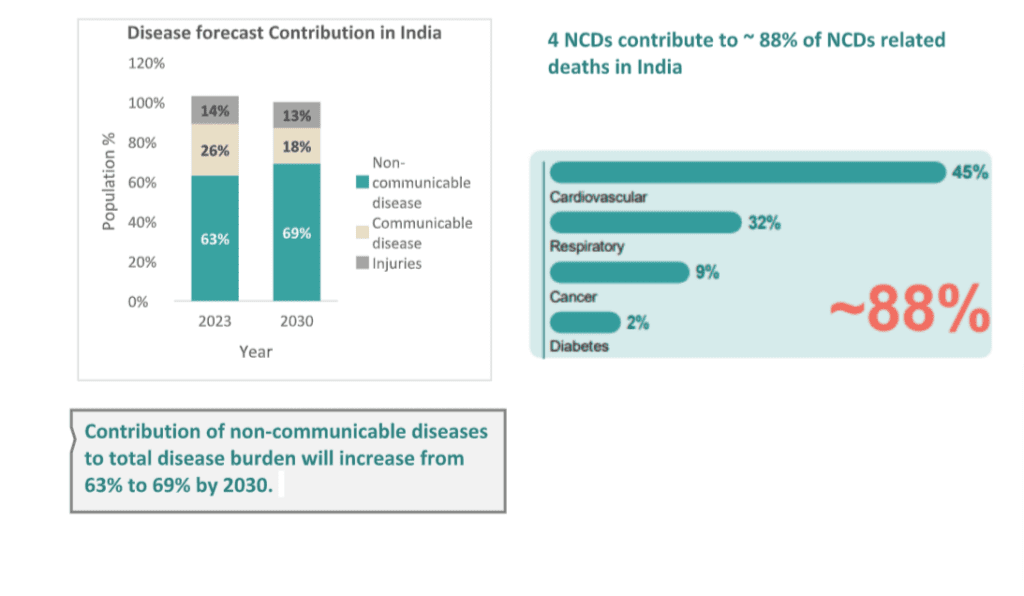
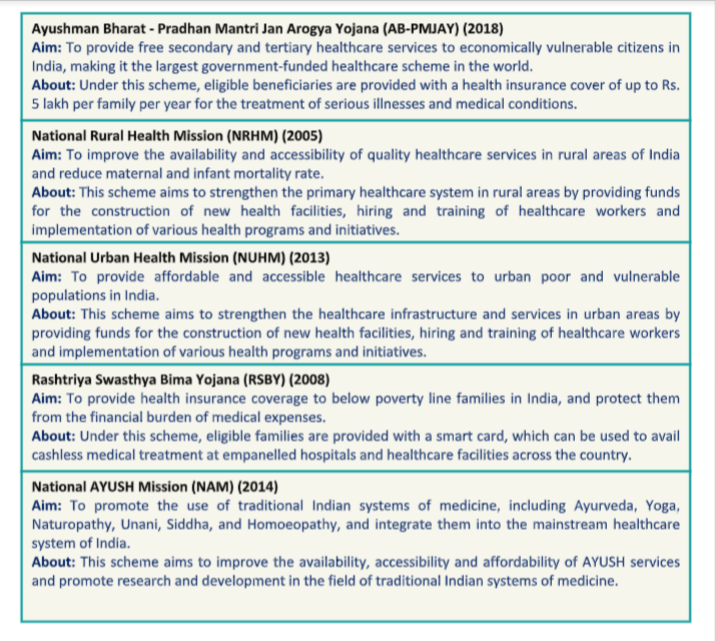
GOVERNMENT INITIATIVES IN HEALTHCARE SECTOR
LIST OF MAJOR HOSPITALS IN INDIA
Top 10 Government Hospital in India
1. AIIMS, New Delhi
It is one of the most renowned medical institutes in India, spread over an area of
213 acres. It was established in 1956 and currently has a total bed strength of
3,000 out of which only less than 10% is dedicated to ICU and HDU beds. The
hospital offers top-notch medical services in various fields and is equipped with
advanced technology to provide the best treatment to patients.
2. CMC, Vellore
The hospital was established in 1900 and is spread over an area of 19 acres. It
has a bed capacity of 2,858 out of which 207 ICU beds and 46 emergency beds.
The hospital has 39 major operation theatres and 14 facilities for minor
procedures.
3. PGIMER, Chandigarh
It was established in 1962 and is spread over an area of 277 acres. The hospital
has a bed capacity of 1,500 and is recognized for excellence in HIV treatment by
NACO.
4. TATA Memorial Hospital, Mumbai
It was founded in 1941 and is spread over an area of 25 acres. It has a bed
capacity of 983 and is known for bone marrow transplantation, blood
transfusion and chemotherapy.
5. King Edward Memorial Hospital, Mumbai
It was established in 1926 and is spread over an area of 16 acres. It has a bed
capacity of 1,800 and sees 1.8 million outpatients and 85,000 inpatients
annually. The major thrust area are gynaecology and nephrology and offers a
wide range of medical services to patients.
6. Safdarjung Hospital, Delhi
The hospital was established in 1926 and is spread over an area of 47 acres. It
has a bed capacity of 1,531 including 40 ICU beds and 32 operation theatre. The
major thrust area are cardiac surgery, urology and nephrology.
7. Deen Dayal Upadhyay Hospital, Delhi
It was established in 1970 and has a bed capacity of 1,531 including 65
emergency beds. The hospital is famous for neurosurgery, psychiatry and plastic
surgery.
8. Dr Ram Manhohar Lohia Hospital, Delhi
The hospital was founded in 1954 and is spread over an area of 30 acres. It has a
bed capacity of 1,532 and is popular for cardiology, cardiothoracic, and vascular
surgery.
9. Lokmanya Tilak Municipal General Hospital, Mumbai
It was established in 1947 and has a bed capacity of 1,462, including 58 ICU beds
and 30 operation theatres.
10. IPGME&R and SSKM Hospital, Kolkata
The hospital was established in 1707 and is spread over an area of 34 acres. It
has 32 ICU beds and is known for its cardiology and gastroenterology speciality.
Source: Deccanherald.com
Top 10 Private Hospitals in India
1. Medanta, Gurgaon
Established in 2009, Medanta is a 43-acre hospital and has a bed capacity of
1250 including 350 ICU beds and 37 operation theatres. It is well-known for its
successful organ transplant procedures.
2. Apollo Hospital, Chennai
The hospital was founded in 1983. It has a 560 beds including 46 ICU beds and
15 operation theatres. It is popular for its expertise in organ transplants and
cardiology.
3. Breach Candy Hospital, Mumbai
The hospital was established in 1950, Breach Candy Hospital has 220 beds and is
renowned for its nursing care, quality diagnostics and pioneering work in
interventional cardiology.
4. Kokilaben Dhirubhai Ambani Hospital, Mumbai
It was established in 2009 on a 0.91-acre area, the hospital has 750 beds
including 120 ICU beds and 21 operation theatres. It is popular for its expertise
in neurosurgery and interventional neuroradiology.
5. Sri Ganga Ram Hospital, Delhi
It was founded in 1954 and has 675 beds. The hospital's Minimal Access Surgery
department was the first such department in South Asia. It has a thrust area in
cardiology and anaesthesiology.
6. Indraprastha Apollo Hospital, Delhi
It was established in 1995 on a 15-acre and has a bed capacity of 710. The
hospital is popular for its cardiology and neurology specialty.
7. Max Super Speciality Hospital, Saket- Delhi
The hospital was founded in 2006 on a 3-acre area with 530+ beds including 51
ICU beds and 12 operation theatres. The hospital is known for its expertise in
neurosurgical operations and knee replacement procedures.
8. Fortis Flt. Lt. Rajan Dhall Hospital, Delhi
The hospital was established in 2006 and is spread over an area of 3.44-acre
with 162+ beds including 50 ICU beds and 6 operation theatres and is a
renowned healthcare provider in North India.
9. Apollo Hospital, Navi Mumbai
It was founded in 1983 and spread over a 16-acre area and has 500 beds
including 120 ICU beds and 13 operation theatres. It is known for its expertise in
bariatric surgery, anaesthesiology and bone marrow transplants.
10. Manipal Hospital, Bangalore
The hospital was established in 1991 and has a bed capacity of 650 including 14
ICU beds and 4 operation theatres. The hospital is popular for its nephrology
department and expertise in kidney transplants.
Source: Newsweek.com
CONCLUSION
The healthcare market in India is on a trajectory of steady growth with increasing
investment and government initiatives paving the way for better healthcare
infrastructure, facilities and services. The focus on preventive, diagnostic, curative and
rehabilitative care services is aimed at ensuring better health outcomes for the
population. With the impressive progress made so far, it is reasonable to expect that the
Indian healthcare sector will continue to grow and contribute significantly to the
country's economy, making it one of the top three contributors in the years to come. As
the sector continues to evolve, the future looks promising for both healthcare providers
and patients in India.
Hospacxx Healthcare Consultancy, likewise, has worked across Indian and International
States on Hospital Projects for Business Process Development, Service Quality
Assurance, Financial Management and more. For more information, you can visit the
company website on www.hospaccxconsulting.com or contact us directly.
















